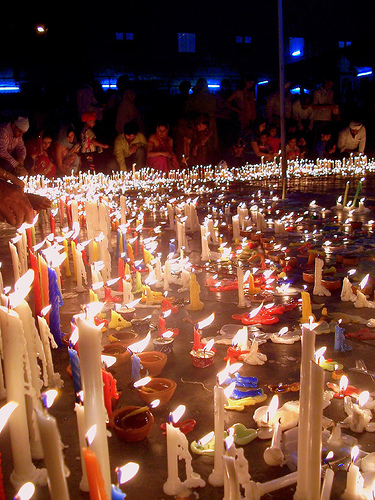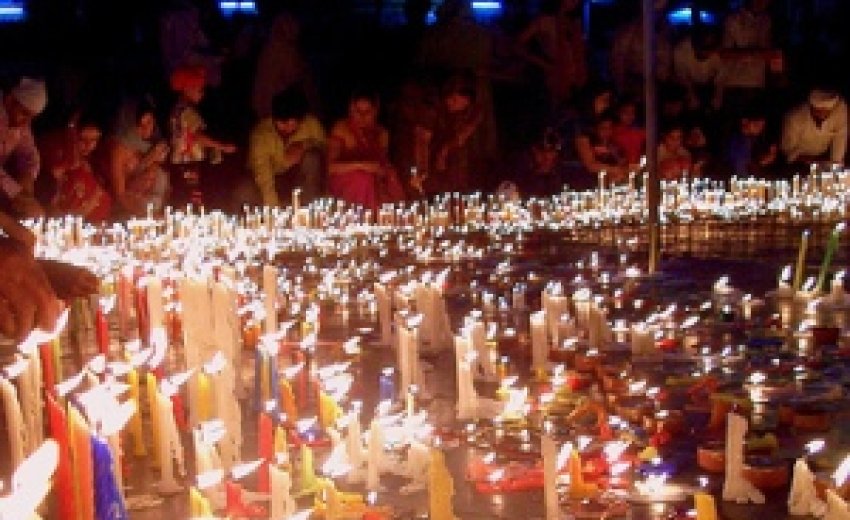 11 Nov, 2012, Washington DC: EcoSikh sent a formal appeal to Jathedar Sri Akal Takhat Sahib to mandate “One Candle One Family” for Sikhs who want to light candles at the Gurdwaras. EcoSikh survey revealed that majority of Sikh families light more than 50 candles in Gurdwaras during Diwali eve.
11 Nov, 2012, Washington DC: EcoSikh sent a formal appeal to Jathedar Sri Akal Takhat Sahib to mandate “One Candle One Family” for Sikhs who want to light candles at the Gurdwaras. EcoSikh survey revealed that majority of Sikh families light more than 50 candles in Gurdwaras during Diwali eve.
These candles are mostly placed haphazardly around parikarma and nishan sahib and other possible places, letting enormous smoke and many accidents every time. With a hope of receiving a message on Green Diwali from Sri Akal Takhat Sahib, EcoSikh referred a wonderful example of ‘three Incents to pray’ by Taoists of China, to Jathedar Giani Gurbachan Singh Ji. Traditionally the Taos used to burn numerous incents for prayers at their temples which led to a permanent cloud of smoke over their historical temple in China. But recently in 2006 the Taoists religious leaders declared that three incents are enough for offering prayer; one for God, one for the earth and one for self. This was well accepted by the followers and as a result the sky over the temple gradually cleared and many birds found habitat in that area.
Diwali, the festival of lights or the Bandi Chhor Diwas is one of the major festivals and Gurpurabs of the Sikhs. On Bandi Chorh Diwas, the long imprisoned Guru Hargobind was released from Fort of Gwalior taking with him 52 long imprisoned Kings, whose release was a result of the Guru's wit. Every year Sikhs in India and all over the world celebrate this day by lighting candles and huge fireworks.
EcoSikh President, Dr. Rajwant Singh said, “the city of Amritsar and the Golden Temple building ought to be preserved environmentally at all costs for the next generations. They deserve to see the Golden Temple and the city of Guru Ram Das Ji as clean and glorified.”
Recent environment campaigns throughout the Sikh community and its headquarters like the Golden Temple, Amritsar has however made some sincere contribution in reducing the use of crackers during this festival in the past years and it will continue.
EcoSikh appreciates the efforts of SGPC for reducing the firework show to 15 minutes in 2011 and recent press release says SGPC has cut short the fireworks to 10 minutes at the Golden Temple. Read the full press release below.
####
|
This Divali, a cracker of an eco step at Golden Temple Amritsar, November 10: Aiming to check pollution around the Golden Temple, the Shiromani Gurdwara Parbandhak Committee (SGPC) has decided to reduce the duration of fireworks to a mere 10 minutes to celebrate Bandi Chhod Diwas and Divali on November 13. The move came after the SGPC failed to find an alternative to the high-altitude fireworks. This is the second successive year when the SGPC has curtailed the duration of fireworks so as to protect the holy shrine from pollution. Last year, the Golden Temple had witnessed fireworks for only 15 minutes on Divali, which was half as compared to previous years. It was for the first time that the SGPC had reduced the duration. Earlier, there used to be a half-an-hour show of fireworks on occasions like Guru Ram Das’s birth anniversary and Bandi Chhod Diwas. Confirming the development, Golden Temple manager Harbans Singh Malhi said, “We have gradually reduced the duration from half an hour to 15 minutes and now to 10 minutes.” He said the fireworks will take place at four spots: two locations close to Ghanta Ghar and one each near Sikh Reference Library and Darshani Deodhi. Malhi, however, clarified that their attempt to look for a better alternative to high-altitude fireworks was still on. “We are in touch with various Sikh organisations abroad and they are helping us in exploring options that will ensure minimum pollution,” he added. The Punjab Pollution Control Board had last year advised the SGPC to ban bursting of firecrackers at the Golden Temple Complex. However, the SGPC had said that they could not discontinue fireworks altogether as it was the traditional way to celebrate the occasion and the devotees sentiments were attached to it. Though the local administration in the past had initiated various measures like banning coal-run hearths being used by goldsmiths around the shrine and providing LPG connections to them, a lot still needs to be done to make the vicinity of the shrine smoke-free. While the number of private vehicles plying in the area is also high, the rickety auto-rickshaws running on adulterated fuel also pose a severe threat to the Golden Temple. The SGPC too is initiating measures like modernising its ‘langar’ facility in a bid to curb pollution. |
Paintings at risk A study conducted by the PPCB had put the respirable suspended particulate matter level around the Golden Temple at a maximum of 227 and a minimum of 124, though it should not be more than 100 microgram/cubic metre around heritage sites. The high level of pollution is causing harm to miniature paintings and gold plating at the shrine, besides leading to corrosion and blackening of white marble. Its adverse effect can be seen on the gold plating on the outer walls of the Akal Takht. Main pollutants
Gradual decline
|

